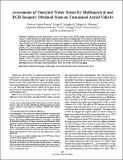Por favor, use este identificador para citar o enlazar a este item:
http://hdl.handle.net/10261/261452COMPARTIR / EXPORTAR:
 SHARE SHARE
 CORE
BASE CORE
BASE
|
|
| Visualizar otros formatos: MARC | Dublin Core | RDF | ORE | MODS | METS | DIDL | DATACITE | |

| Título: | Assessment of vineyard water status by multispectral and rgb imagery obtained from an unmanned aerial vehicle |
Autor: | López-García, Patricia; Intrigliolo, Diego S. CSIC ORCID; Moreno, Miguel A.; Martínez-Moreno, Alejandro; Ortega, Jose F.; Pérez-Álvarez, Eva Pilar CSIC ORCID; Ballesteros, Rocío | Palabras clave: | Multispectral images RGB images Stem water potential UAV Vineyard Water stress |
Fecha de publicación: | 8-jun-2021 | Editor: | American Society for Enology and Viticulture | Citación: | American Journal of Enology and Viticulture 72: 285-297 (2021) | Resumen: | Multispectral and conventional cameras (red, green, blue [RGB] imager) onboard unmanned aerial vehicles (UAVs) provide very high spatial, temporal, and spectral resolution data. To evaluate the capacity of these techniques to assess vineyard water status, we carried out a study in a cv. Monastrell vineyard located in southeastern Spain in 2018 and 2019. Several irrigation strategies were applied, including different water quality and quantity regimes. Flights were performed using conventional and multispectral cameras mounted on the UAV throughout the growth cycle. Several visible and multispectral vegetation indices (VIs) were determined from the images with only vegetation (without soil and shadows, among others). Stem water potential was measured by pressure chamber, and the water stress integral (Sψ) was obtained during the season. Simple linear regression models that used VIs and green cover canopy (GCC) to predict Sψ were tested. The results indicate that visible VIs best correlated with Sψ. The green leaf index (GLI), visible atmospherically resistant index (VARI), and GCC showed the best fits in 2018, with R = 0.8, 0.72, and 0.73, respectively. When the best model developed with the 2018 data was applied to the 2019 data set, the model fit poorly. This suggests that on-ground measurements of vine stress must be taken each growing season to redevelop a model that predicts water stress from UAV-based imaging. | Versión del editor: | http://dx.doi.org/10.5344/ajev.2021.20063 | URI: | http://hdl.handle.net/10261/261452 | DOI: | 10.5344/ajev.2021.20063 | Identificadores: | doi: 10.5344/ajev.2021.20063 issn: 0002-9254 |
| Aparece en las colecciones: | (CEBAS) Artículos |
Ficheros en este ítem:
| Fichero | Descripción | Tamaño | Formato | |
|---|---|---|---|---|
| LopezGarcia2021AJEV.pdf | 1,34 MB | Adobe PDF |  Visualizar/Abrir |
CORE Recommender
Page view(s)
30
checked on 30-abr-2024
Download(s)
46
checked on 30-abr-2024
Google ScholarTM
Check
Altmetric
Altmetric
Este item está licenciado bajo una Licencia Creative Commons

